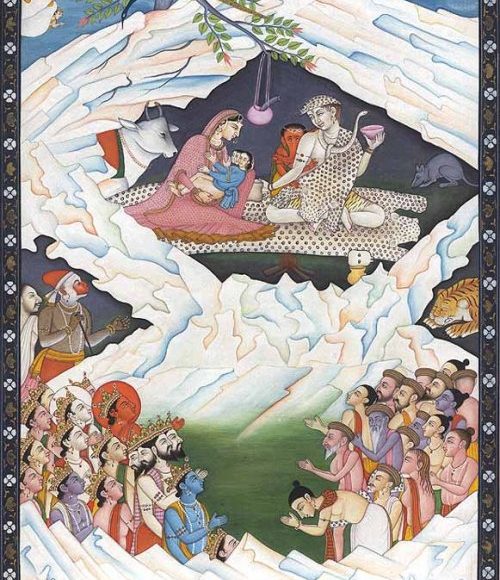Whose Praises are sung by Brahma (Birancha) alongwith the hymns of the Vedas and for whom Shiva (the ascetic) holds fast on the Kahlasa (Kailasa) mountain and does not leave it… (Swayye Mahle Chauthe Ke, p. 1404) Kailasa is a mountain situated like Meru to the north of Himalayas. The beautiful Manasarovar lake lies towards its south. Shiva\’s paradise (Shivapuri) is said to be a Mount Kailasa. Kuvera\’s abode is also there. It is also called Ganaparvata.
References :
1. Kohli, Surindar Singh (ed), Dictionary of Mythological References in Guru Granth Sahib, 1993
Mount Kailasa in Mythology
- Lord Shiva’s Abode: Kailasa is described in Hindu scriptures as the celestial home of Lord Shiva and his consort, Goddess Parvati. It is envisioned as a paradise where all divine beings gather, and where Shiva performs his cosmic dance of creation and destruction—the Tandava.
- Churning of the Ocean: The mythological episode of the churning of the ocean (Samudra Manthan) also links Shiva to Kailasa. After consuming the poison (halahala) to save the world, Shiva resides in Kailasa, representing his transcendence over worldly afflictions.
Sacred Geography
Mount Kailash is an actual peak located in Tibet, standing at an altitude of over 6,600 meters. Its isolation, pyramid-like shape, and surrounding lakes, such as Lake Mansarovar and Lake Rakshastal, contribute to its mystical aura. Pilgrims believe circumambulating Kailasa (known as parikrama or kora) washes away sins and leads to liberation.
Philosophical Significance
- Axis Mundi: Kailasa is often considered the “Axis Mundi” or the cosmic axis in Hindu, Buddhist, and Jain traditions. It represents the spiritual connection between heaven and earth, signifying balance and harmony.
- State of Enlightenment: Symbolically, Kailasa represents the peak of spiritual attainment. It is not merely a physical place but a metaphor for the highest state of consciousness, where one merges with the divine.
Cross-Cultural Reverence
- In Buddhism, Kailasa is associated with Mount Meru, the center of the universe in Buddhist cosmology. It is revered as the abode of Demchok, a wrathful manifestation of Buddha representing supreme bliss.
- In Jainism, Kailasa is considered sacred as the site where Rishabhadeva, the first Tirthankara, attained liberation.
- In the Bon religion (pre-Buddhist tradition of Tibet), Mount Kailasa is the sacred seat of the sky god.
Mystical Descriptions in Scriptures
Kailasa is vividly described in Hindu texts such as the Shiva Purana, Skanda Purana, and Mahabharata. It is portrayed as a mountain made of crystal, shimmering with divine energy, and surrounded by forests, rivers, and celestial beings. Its summit is said to glow with the radiance of Shiva’s presence.
Pilgrimage and Rituals
Devotees undertake the arduous pilgrimage to Kailasa as an act of devotion and penance. The circumambulation of the mountain (spanning 52 kilometers) is completed in a clockwise direction by Hindus and Buddhists, while Jains and followers of Bon perform it counterclockwise. The trek symbolizes surrender to the divine and the journey toward spiritual transformation.



